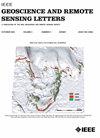Ship Detection and Direction Finding Based on Time-Frequency Analysis for Compact HF Radar
IF 4
3区 地球科学
Q2 ENGINEERING, ELECTRICAL & ELECTRONIC
引用次数: 28
Abstract
Ship detection at the sea surface is important for improving human marine activities. Most existing ship detection methods for high-frequency surface wave radar (HFSWR) are based on peak and constant false alarm rate (CFAR) detection and require a coherent integration time (CIT) of several minutes. However, in such a long period, the target may not be stationary. To account for the nonstationary property, a time-frequency analysis (TFA)-based ship detection and direction finding (DF) method is proposed for HFSWR. Target ridges on the TF representation (TFR) of the echo data are detected first. Next, array snapshots are formed by sampling the extracted ridges and are used to estimate the direction of arrival (DOA). The processing results of the radar data collected at Dongshan, Fujian Province, China, show that the proposed method outperforms the CFAR method with both increased detection rates and decreased DF errors, especially under relatively low signal-to-noise ratio (SNR) scenarios.基于时频分析的小型高频雷达舰船探测与测向
海面船舶探测对改善人类海洋活动具有重要意义。现有的高频表面波雷达(HFSWR)舰船检测方法大多基于峰值和恒定虚警率(CFAR)检测,且需要数分钟的相干积分时间(CIT)。然而,在这么长的时间里,目标可能不是静止的。针对高频短波信号的非平稳性,提出了一种基于时频分析(TFA)的舰船检测测向方法。首先检测回波数据的TF表示(TFR)上的目标脊。然后,通过采样提取的脊形成阵列快照,并用于估计到达方向(DOA)。对福建东山雷达数据的处理结果表明,在较低信噪比的情况下,该方法在提高检测率和减小DF误差方面优于CFAR方法。
本文章由计算机程序翻译,如有差异,请以英文原文为准。
求助全文
约1分钟内获得全文
求助全文
来源期刊

IEEE Geoscience and Remote Sensing Letters
工程技术-地球化学与地球物理
CiteScore
7.60
自引率
12.50%
发文量
1113
审稿时长
3.4 months
期刊介绍:
IEEE Geoscience and Remote Sensing Letters (GRSL) is a monthly publication for short papers (maximum length 5 pages) addressing new ideas and formative concepts in remote sensing as well as important new and timely results and concepts. Papers should relate to the theory, concepts and techniques of science and engineering as applied to sensing the earth, oceans, atmosphere, and space, and the processing, interpretation, and dissemination of this information. The technical content of papers must be both new and significant. Experimental data must be complete and include sufficient description of experimental apparatus, methods, and relevant experimental conditions. GRSL encourages the incorporation of "extended objects" or "multimedia" such as animations to enhance the shorter papers.
 求助内容:
求助内容: 应助结果提醒方式:
应助结果提醒方式:


